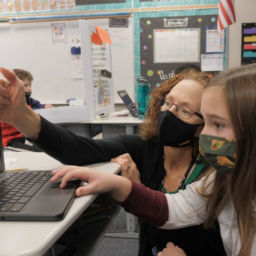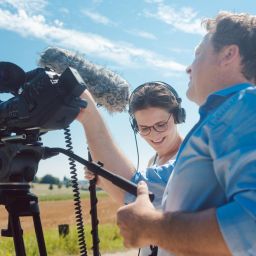
One of the most common challenges in school marketing is knowing how to prepare for a video shoot. Many schools want a professional video, but are unsure what topics to highlight or how to get started. The result can be a missed opportunity to tell the right story. With some preparation, you can identify the goals for your video, streamline the filming process, and make sure the final product resonates with your audience.
6 Essential Questions to Ask Before Video Production
Before the cameras start rolling, it is essential to pause and plan. Asking these six key questions will help you clarify your message, stay organized, and make the most of your school’s video investment.
1. Who Is Your Target Audience?
Before anything else, define who your video is for. Are you hoping to reach current parents, students, prospective families, or the broader community? Each group has different motivations and interests, and understanding them will help you craft a message that connects. For example, a recruitment video for new students should look and sound very different from a video highlighting student achievements.
Identifying your target audience makes the creative process easier. Your story, tone, and visuals should align with the people you want to engage. The clearer the focus, the stronger your impact.
Check out this video to learn more about narrowing down your audience.
2. Will There Be a Central Theme?
A clear, unifying theme ties your story together and gives your video purpose. Consider messages such as “Small School, Big Opportunities” or “Innovation in Every Classroom.” These themes can help your audience remember your school’s key strengths long after they have finished watching.
Having a central theme also guides decisions throughout the production process. From choosing interview questions to selecting visuals, a consistent theme ensures that every piece of your video supports the same goal. This focus can transform an average school video into a powerful storytelling tool.
Our Hamilton Heights alumni athlete video features a central theme of successful and impactful alumni legacies. Check out how these videos demonstrate the cohesiveness and impact when you have a central theme in “Celebrating Hall of Fame Athletes: The Power of Video Storytelling.”
3. What Topics Will Be Covered?
Once you have selected a central theme, it’s time to outline the main topics your video should address. These might include academics, student life, extracurricular activities, or community involvement. For instance, Boost Engagement in Your School’s Extracurriculars with Video Promotion focuses on extracurricular activities and explains how video can help promote them.
Listing your priorities early ensures that filming time is used effectively and that no critical content is missed. A clear outline also helps in post-production. When your editor knows which talking points are essential, they can craft a story that stays on message and aligns with your original goals.
4. Who Will Be on Camera?
The people you feature are the heart of your video. Selecting students, teachers, or administrators who are the best fit for the video’s theme can significantly impact the authenticity of your story. Select those who are comfortable or engaging on camera and who naturally reflect your school’s mission and personality.
If you are planning to use voiceover narration, draft your script early. This will help you determine the visual footage needed to match the story.
Watch this video for advice on writing a script.
5. Where Should You Film?
Choosing the right locations sets the tone for your story. It’s best to follow the central theme and find a space that effectively represents it. For instance, a science lab communicates innovation and hands-on learning, while a library conveys focus, literacy, and community. Consider areas with clean backgrounds, natural lighting, and minimal noise, as these are key to creating a professional look.
Scouting your locations ahead of time helps the production crew plan equipment needs and camera angles. The bigger the space, the more room production has to set up. Remember, your preparation will prevent delays on filming day.
Watch this video for a quick guide to selecting filming locations.
6. What Is Your Timeline?
Every strong production begins with a realistic schedule. Working backward from your desired completion date will help you plan for scriptwriting, filming, editing, and revisions. School schedules can get pretty busy, so building in buffer time ensures you will not be rushing at the last minute.
Establishing a clear timeline also helps your media partner stay aligned with your expectations. When everyone is aware of the milestones, the project progresses smoothly from concept to delivery.
Share Your Video Across Multiple Platforms
Once your video is finalized, you can share it across multiple platforms, including your website, social media, YouTube, and even email campaigns. Each platform offers unique opportunities to connect with your audience. For example, a short highlight reel may perform best on social media, whereas a full-length video will shine on your website.
Strategic distribution extends the lifespan of your content and helps reach your community wherever they are most active. Sharing your video on YouTube boosts your school’s visibility through search and discoverability. Meanwhile, email campaigns with embedded videos consistently see higher engagement and click-through rates. By maximizing your video’s reach, you ensure that your message continues to work for you long after the cameras stop rolling.
Ready to Tell Your School’s Story?
By answering these six questions before filming, you will set the stage for a successful, stress-free production process. You will also ensure that your final video communicates your message clearly and effectively.
Download our free Next Steps Worksheet to guide your planning, then contact us to schedule your next project. Let’s bring your school’s story to life!
















